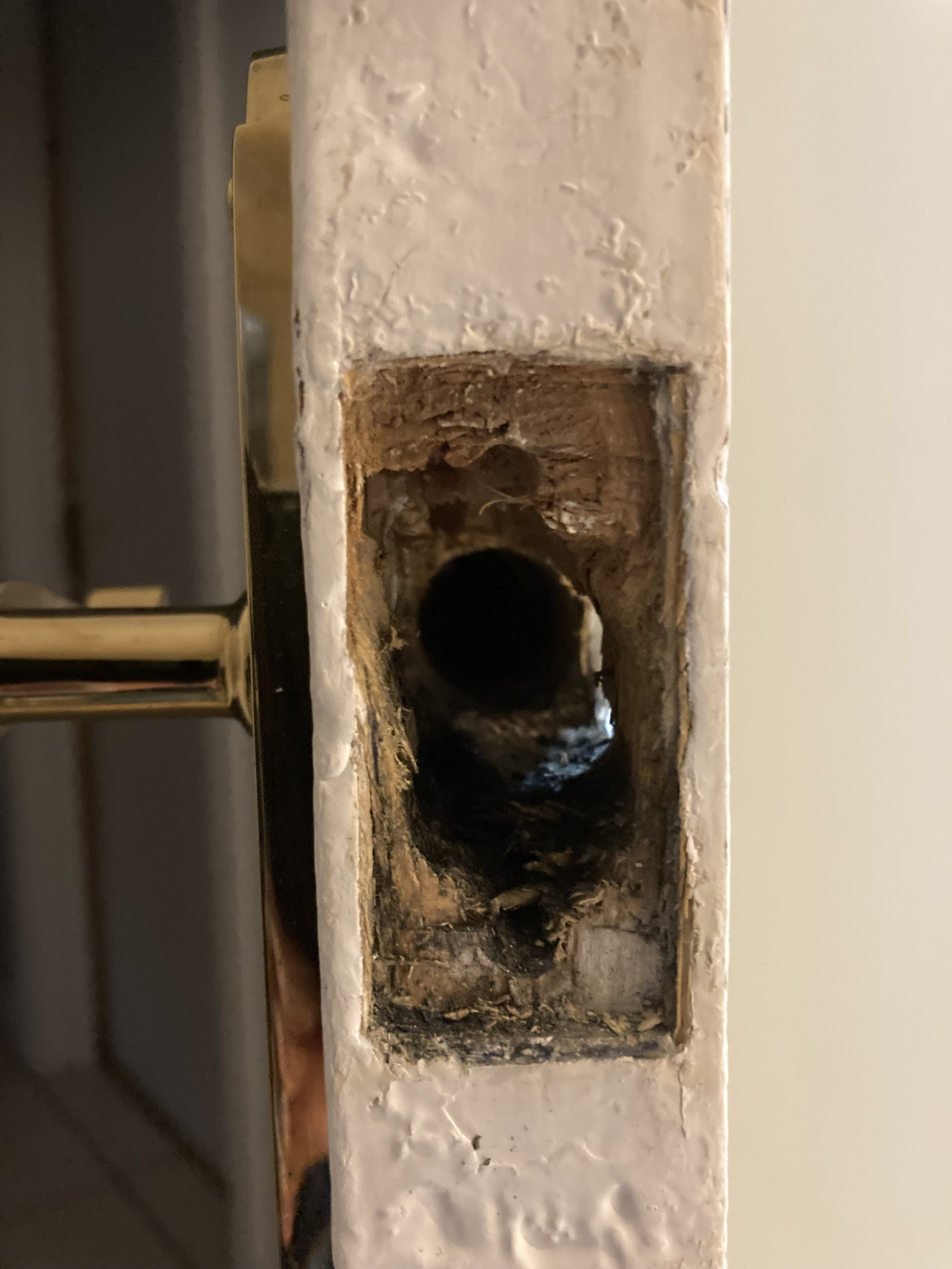We'd like to remind Forumites to please avoid political debate on the Forum... Read More »
📨 Have you signed up to the Forum's new Email Digest yet? Get a selection of trending threads sent straight to your inbox daily, weekly or monthly!
Internal door lock latch can’t be screwed into door
dr_bogenbroom
Posts: 108 Forumite






So this might a bit of a pathetic DIY question but I’m wondering if anyone has any tricks up their sleeve for this small issue I have.
The wood where the latch used to screw into has disintegrated so it no longer secured in causing it to stick out and catch the strike. I could use filler to build it up but I don’t think this will work. Any suggestions?

The wood where the latch used to screw into has disintegrated so it no longer secured in causing it to stick out and catch the strike. I could use filler to build it up but I don’t think this will work. Any suggestions?

0
Comments
-
Use much longer screws?
 0
0 -
It’s a hollow door unfortunately- I thought about that but the screws would need to be super long!ThisIsWeird said:Use much longer screws? 1
1 -
I'd try drilling at a slightly downward angle where the screw goes, tiny drill bit, and then try and screw the latch on at the same angleMr Generous - Landlord for more than 10 years. Generous? - Possibly but sarcastic more likely.1
-
What DIY stuff do you have available to you? Bits of wood and PVA?
Ideal if you also had a bit of tubing of the rough size of the latch tube. A wee bit of plastic plumbing or waste pipe? Cut a 2" piece, and slice down one side - overlap the edges to make it small enough to slip in, and release. You can then coat bits of timber in PVA and press them in to the surrounding - they will take a good couple of days to dry fully.
Absolutely push longer pieces in to the old screw holes.
When fully dry, remove sleeve, and use chisel or knife to trim away high spots.1 -
Great thank you - this is what I needed! Although I’m going to have to post an after pic to prove I can do it…ThisIsWeird said:What DIY stuff do you have available to you? Bits of wood and PVA?
Ideal if you also had a bit of tubing of the rough size of the latch tube. A wee bit of plastic plumbing or waste pipe? Cut a 2" piece, and slice down one side - overlap the edges to make it small enough to slip in, and release. You can then coat bits of timber in PVA and press them in to the surrounding - they will take a good couple of days to dry fully.
Absolutely push longer pieces in to the old screw holes.
When fully dry, remove sleeve, and use chisel or knife to trim away high spots.1 -
I've taken to using Gorilla Glue - You only need a thin smear, and it foams up to fill most gaps. Not very cheap, but well worth it sometimes.ThisIsWeird said: You can then coat bits of timber in PVA and press them in to the surrounding - they will take a good couple of days to dry fully.
Any language construct that forces such insanity in this case should be abandoned without regrets. –
Erik Aronesty, 2014
Treasure the moments that you have. Savour them for as long as you can for they will never come back again.2 -
FreeBear said:I've taken to using Gorilla Glue - You only need a thin smear, and it foams up to fill most gaps. Not very cheap, but well worth it sometimes.A very good alternative, and sets hard in a few hours.If you use this, bear in mind a few things; it's messy, and sticks to everything, including yer fingers. Although it foams and gap-fills, still try and use just enough to coat each piece of timber and not use an excess, and pack the bits in tightly - the tighter, the stronger. And, once you tap the coated bits of wood in to the space (again concentrating on the old screw hole - make sure that has full wood in it), wrap short strips of sellotape horizontally across the job with slight overlaps, in order to contain the expanding foam!Another thing to consider - PVA won't adhere to the plastic tube, but gorilla will do so to some extent. Compress the overlapped tube together to make it smaller, and see if it comes away from the glued section ok. Or possibly wrap a thin layer of clingfilm around it snugly first, before fitting.
0
Confirm your email address to Create Threads and Reply

Categories
- All Categories
- 351.4K Banking & Borrowing
- 253.3K Reduce Debt & Boost Income
- 453.8K Spending & Discounts
- 244.4K Work, Benefits & Business
- 599.7K Mortgages, Homes & Bills
- 177.2K Life & Family
- 258K Travel & Transport
- 1.5M Hobbies & Leisure
- 16.2K Discuss & Feedback
- 37.6K Read-Only Boards


